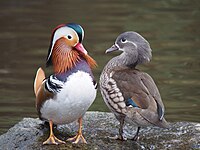
Female ornamentation and the fecundity trade‐off in a sex‐role reversed pipefish
Sign Up to like & getrecommendations! Published in 2018 at "Ecology and Evolution"
DOI: 10.1002/ece3.4459
Abstract: Abstract Sexual ornaments found only in females are a rare occurrence in nature. One explanation for this is that female ornaments are costly to produce and maintain and, therefore, females must trade‐off resources related to… read more here.
Keywords: ornamentation; fecundity; female ornamentation; role reversed ... See more keywords

Trade‐off between fecundity and survival generates stabilizing selection on gall size
Sign Up to like & getrecommendations! Published in 2020 at "Ecology and Evolution"
DOI: 10.1002/ece3.6682
Abstract: Abstract Complex interactions within multitrophic communities are fundamental to the evolution of individual species that reside within them. One common outcome of species interactions are fitness trade‐offs, where traits adaptive in some circumstances are maladaptive… read more here.
Keywords: trade; fecundity; gall size; survival ... See more keywords

Influence of multiple predators decreases body condition and fecundity of European hares
Sign Up to like & getrecommendations! Published in 2022 at "Ecology and Evolution"
DOI: 10.1002/ece3.8442
Abstract: Abstract We assessed the hypothesized negative correlation between the influence of multiple predators and body condition and fecundity of the European hare, from 13 areas in the Netherlands. Year‐round abundance of predators was estimated by… read more here.
Keywords: influence multiple; multiple predators; body condition; fecundity ... See more keywords

A change in the bacterial community of spider mites decreases fecundity on multiple host plants
Sign Up to like & getrecommendations! Published in 2019 at "MicrobiologyOpen"
DOI: 10.1002/mbo3.743
Abstract: Bacterial symbionts may influence the fitness of their herbivore hosts, but such effects have been poorly studied across most invertebrate groups. The spider mite, Tetranychus truncatus, is a polyphagous agricultural pest harboring various bacterial symbionts… read more here.
Keywords: community; spider mites; fecundity; host plants ... See more keywords

Sublethal effects of chlorfenapyr on Plutella xylostella (Lepidoptera: Plutellidae).
Sign Up to like & getrecommendations! Published in 2022 at "Pest management science"
DOI: 10.1002/ps.7175
Abstract: BACKGROUND The diamondback moth (DBM), Plutella xylostella (L.), is the most destructive pest of cruciferous vegetables worldwide. Chlorfenapyr is an important insecticide for controlling DBM. The impacts of three sublethal doses (LC1 , LC10 and… read more here.
Keywords: sublethal effects; plutella xylostella; rate; effects chlorfenapyr ... See more keywords

Inbreeding depression causes reduced fecundity in Golden Retrievers
Sign Up to like & getrecommendations! Published in 2019 at "Mammalian Genome"
DOI: 10.1007/s00335-019-09805-4
Abstract: Inbreeding depression has been demonstrated to impact vital rates, productivity, and performance in human populations, wild and endangered species, and in recent years, the domestic species. In all cases, standardized, high-quality phenotype data on all… read more here.
Keywords: causes reduced; fecundity; depression causes; golden retrievers ... See more keywords

A comparison of two methods for quantifying parasitic nematode fecundity
Sign Up to like & getrecommendations! Published in 2017 at "Parasitology Research"
DOI: 10.1007/s00436-017-5436-8
Abstract: Accurate measures of nematode fecundity can provide important information for investigating parasite life history evolution, transmission potential, and effects on host health. Understanding differences among fecundity assessment protocols and standardizing methods, where possible, will enable… read more here.
Keywords: two methods; fecundity; method; egg ... See more keywords

Dual effects of insect fecundity overdispersion on the Wolbachia establishment and the implications for epidemic biocontrol
Sign Up to like & getrecommendations! Published in 2021 at "Journal of Pest Science"
DOI: 10.1007/s10340-021-01331-0
Abstract: The utilization of the most prevalent endosymbionts Wolbachia spp. to tackle insect-borne viral diseases is growing rapidly. Understanding how and how often Wolbachia establish in a local population is fundamental to replacement releases but remains… read more here.
Keywords: insects; fecundity; fecundity overdispersion; wolbachia establishment ... See more keywords

Fecundity for free? Enhanced oviposition in longevous populations of Drosophila melanogaster
Sign Up to like & getrecommendations! Published in 2018 at "Biogerontology"
DOI: 10.1007/s10522-018-09791-1
Abstract: Artificial selection for increased life span in experimental populations of Drosophila melanogaster sometimes produces long-lived populations that exhibit greater fecundity than unselected controls. The absence of a trade-off between survival and reproduction in these cases… read more here.
Keywords: oviposition; populations drosophila; fecundity; drosophila melanogaster ... See more keywords

Is the Orton’s rule still valid? Tropical sponge fecundity, rather than periodicity, is modulated by temperature and other proximal cues
Sign Up to like & getrecommendations! Published in 2018 at "Hydrobiologia"
DOI: 10.1007/s10750-018-3562-7
Abstract: Although the Orton’s rule was already questioned for several invertebrate lineages, it remains unchallenged in sponges. To assess its validity in Porifera, we investigated the reproductive cycle of five species of Demospongiae on a tropical… read more here.
Keywords: temperature; periodicity; fecundity; orton rule ... See more keywords

Detecting the Effects of Early-Life Exposures: Why Fecundity Matters.
Sign Up to like & getrecommendations! Published in 2019 at "Population research and policy review"
DOI: 10.1007/s11113-019-09562-x
Abstract: Prenatal exposures have meaningful effects on health across the lifecourse. Innovations in causal inference have shed new light on these effects. Here, we motivate the importance of innovation in the characterization of fecundity, and prenatal… read more here.
Keywords: survival bias; fecundity; effects early; detecting effects ... See more keywords